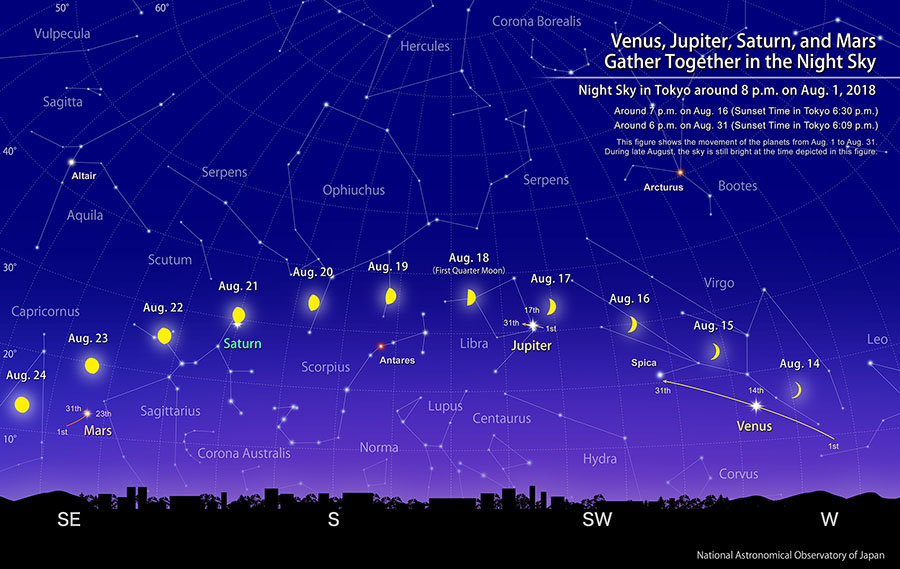Venus, Jupiter, Saturn, and Mars Gather Together in the Night Sky (August, 2018)

Let’s Look for Four Planets in a Line!
In early August, Venus, Jupiter, Saturn, and Mars gather together in the night sky. It is very unusual for four planets to line up at the same time. Let’s look for all of the planets from a wide area with few objects blocking your view!
Venus shines brightly in the western sky near the horizon. When you look left from Venus, Jupiter stands out brightly, although not as brightly as Venus, in the southwestern sky. When you look further to the left in the southeastern sky, although it is dimmer than the other three planets, you can find Saturn, which stands out from other celestial objects. Near the horizon in the southeastern sky, Mars having just passed its closest approach to the Earth, shines brighter than Jupiter.
The appropriate time for observation is from 30 minutes after sunset to one and a half hours after sunset. If you observe too early, Saturn is difficult to find because the sky is not dark yet. On the other hand, if you observe too late, the altitude of Venus becomes low. This makes Venus hard to see, or it might have already set. You can see four planets lined up together at the same time as the sky slowly darkens starting from 30 minutes after sunset.
The four planets get closer little by little and they can be seen simultaneously until the end of August. However, from late August to early September, the altitude of Venus gradually decreases, making it difficult to see.
From August 14 to August 23, the Moon passes close to these four planets one after another. On August 14 and August 15, the Moon approaches close to Venus. And on August 17, the Moon moves to the upper right of Jupiter, passing very near to Jupiter. On August 21, it approaches within about 1.5 degrees of Saturn. This means that the distance between the center of the Moon and Saturn becomes very close; only three times the diameter of the Moon. The Moon passes close to Mars on August 23. When you see the thin Moon waxing day by day and moving between the planets and stars (Note 1), you can feel the movement of the Moon which most of us are usually unaware of. Also, you can see that the Moon and planets follow almost the same path (Note 2).
(Note 1) This does not mean that you can see the movement while you are watching. Instead, it means that when you look the next day, the position of the Moon is quite different from the day before. Back
(Note 2) Both the Moon and planets move close to the ecliptic (the path of the Sun). For that reason, the Moon does not approach close to stars which are far away from the ecliptic, for example Vega. Back
Mars, which made its closest approach to the Earth at the end of July, shines bright red.
Reference: Ephemeris Computation Office
With the “Sky Viewer” you can easily explore the appearance of a typical urban night sky (planets and constellations are visible). The Celestial Phenomena section of the glossary explains the planetary phenomena terms: greatest elongation, opposition, conjunction, stationary, etc.